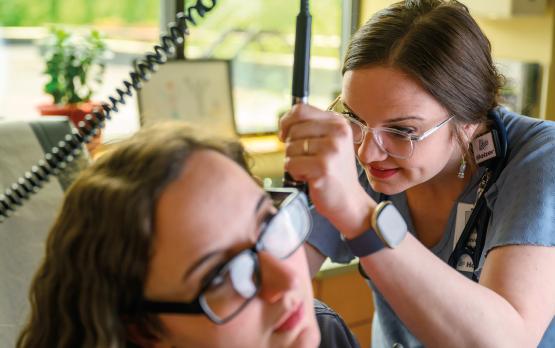
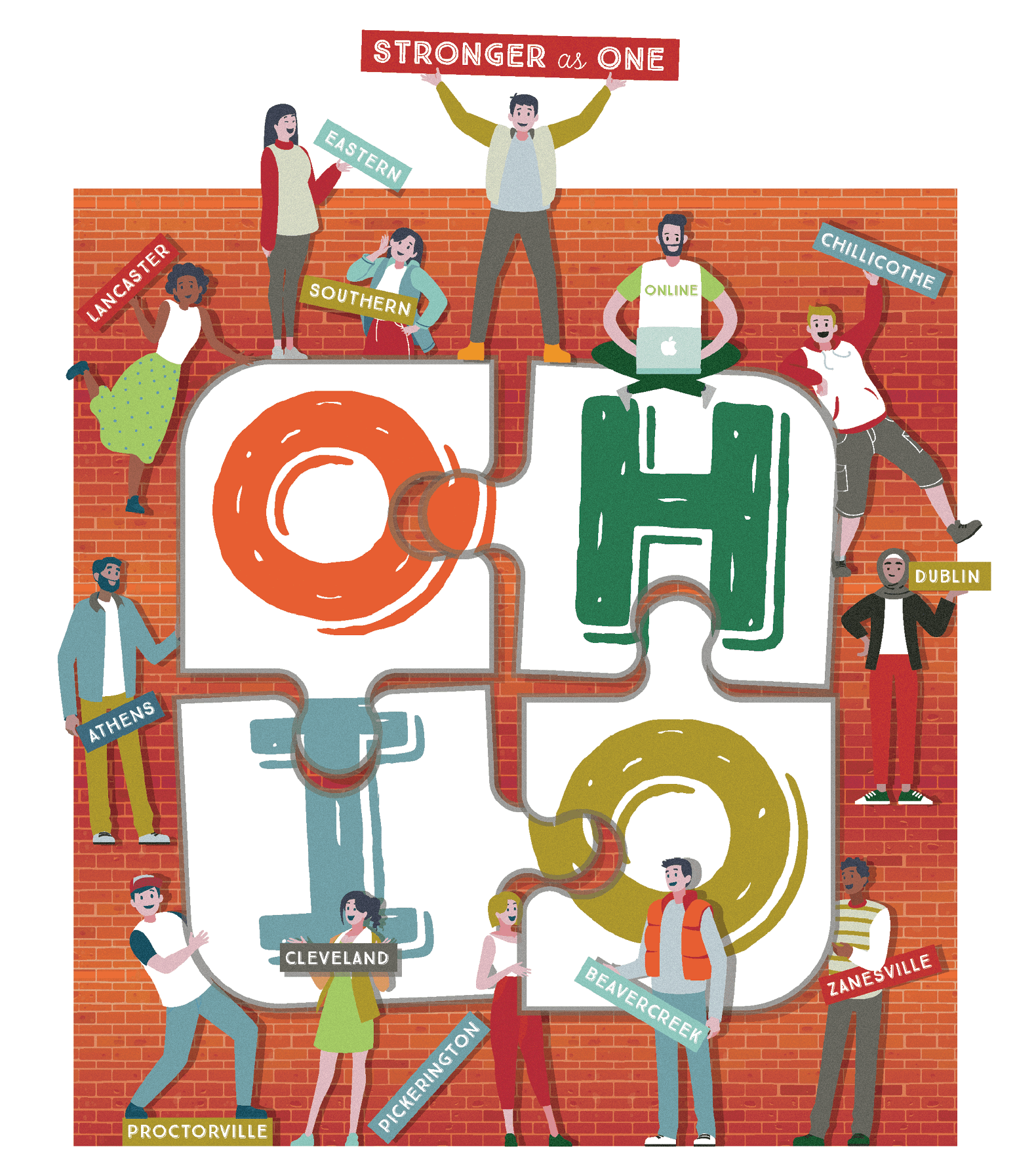
OHIO Unified
This fall marks the 75th anniversary of Ohio University’s first regional campuses, formally established to serve World War II veterans returning from the front lines with GI Bill benefits in hand and dreams for their post-service lives.
Angela Woodward, BSJ '98 | September 1, 2021
Share:
One OHIO initiative strengthening campus, communities in purpose and partnership
It was a milestone in a history of community outreach, dating back to the turn of the century when access to an OHIO education was first extended beyond Athens. In opening its doors to the greater Southeast Ohio region, the University took root in communities that not only welcomed its presence and purpose but were instrumental in building what would become a five-campus regional higher education system.
Over the past three years, faculty and staff University-wide have been examining the operations and impact of OHIO’s multi-campus system—an Ohio University pawprint that now also includes two extension campuses, three satellite locations and numerous online programs.
What has emerged is the development and first steps of a strategic initiative that is uniting the University in its purpose, in its partnerships with the communities it serves and the industries that call those communities home, and in response to local and regional needs. Aptly named One OHIO, the strategic initiative is ushering in a modern-day approach to collaboration, curricular innovation and workforce development.
“At the heart of One OHIO is a belief that we are stronger as one,” says Dr. Nicole Pennington, executive dean of Regional Higher Education and Lifelong Learning, dean of campus and community relations at Ohio University Southern, and co-chair of One OHIO. “Ohio University created this network of campuses to expand access to higher education and to opportunity, and to enrich and contribute to our communities, our state and beyond. We do that better when we operate as One OHIO.”
UNIFYING FROM WITHIN
Under One OHIO, Ohio University is, for the first time in its history, operating as a unified university system, leveraging the full power of its network and cultivating an ecosystem that better serves its students and mission.
Administrative functions essential to every campus—from libraries and facilities to information technology—have been aligned, providing a more consistent, coordinated and efficient level of service University-wide. And regional campus faculty have been integrated into colleges on the Athens Campus, fostering collegiality and creating a larger scholarly community among OHIO’s educators.
“One of the neat things that One OHIO did by making regional campus faculty also members of their Athens Campus departments is it brought them into a lot of ongoing discussions—about curriculum, assessment, research, the role we want internships and career- and skill-building experiences to play, and where we want the department, the college, the University to go in the future,” says Dr. Sarah Poggione. “It’s allowed us to engage our colleagues more and more often and broadened our opportunities.”
Poggione, professor of political science and the College of Arts and Sciences’ associate dean for students, instruction and curriculum, points to how faculty are increasingly sharing classes, extending the expertise on each campus to more students. She also notes how the college worked in groups of faculty across campuses to develop interdisciplinary courses incorporated into OHIO’s new general education curriculum.
“We began working intentionally to share resources and expertise across campuses before One OHIO, but the initiative has helped us formalize mechanisms for collaboration,” she says. “The spirit of One OHIO to me is really enhancing that collaboration, the sharing of information and communication among faculty and making sure that we are part of the same team to serve our students.”
OHIO’s School of Nursing has been operating as a unified program for years. It’s a system that Dr. Elizabeth Delaney, BSN ’97, associate professor of nursing at Ohio University Southern, believes has made the nursing program stronger in its curriculum and its students stronger in their skillsets.
“It makes our students stronger because they benefit from all of this expertise from other locations and from us collaborating to put together a best practices standard for our program,” she says.
Delaney acknowledges that developing this unified paradigm didn’t happen overnight or without growing pains, but it has nurtured a student-centered mindset.
“It helps you look at the bigger picture. As a group, you have to really think about what’s best for the student,” she says. “Plus, the faculty benefit from all of this expertise, collaboration and innovation. We see where we can help each other.”
For John McCarthy, the positive outcomes of One OHIO have been greater connection, communication and understanding of each campus’ resources, strengths and unique identity—and then finding common ground and opportunities to support student and faculty success.
“There’s considerable value in being a part of something smaller that’s part of something bigger,” says McCarthy, professor of communication disorders and interim dean of the College of Health Sciences and Professions. “We live in an interconnected world, which is mirrored in this new system of operating. It opens up a lot of opportunities and support.”
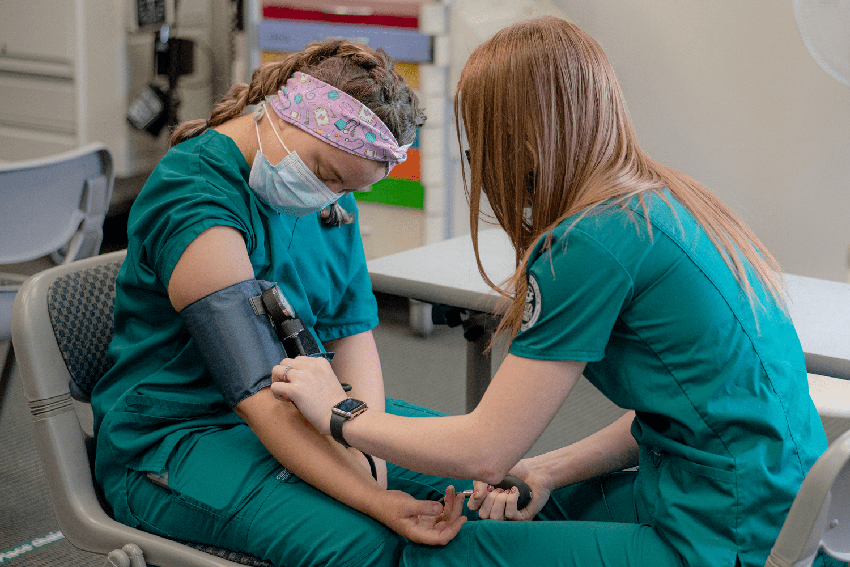
Pictured are nursing students inside the classroom at Ohio University Southern. Photo by Rich-Joseph Facun, BSVC ’01
TUNING INTO THE COMMUNITY
One of the tenets of One OHIO is a renewed focus on community engagement—an acknowledgement of the interdependence of town and gown reflected in everything from presidential priorities to discussions about regional representation on the University’s Board of Trustees.
“We seek to be integral partners with the communities where our regional campuses are located—to be accessible and responsive and for them to know they’ll be heard,” says Dr. Jarrod Tudor. “We continue to build and expand relationships that serve our students and our communities.”
Tudor leads the Lancaster Campus as dean of campus and community relations—a new and deliberate leadership title on OHIO’s regional campuses, which have welcomed four new deans over the past year.
The deans have been establishing consistent engagement with local government and business leaders, school districts, nonprofits and service organizations, increasing opportunities to support each other’s work and to meet existing and emerging needs.
“Each campus has different needs in the community,” notes Dean David Rohall, who leads the Eastern Campus. “Very early on especially, I focused on the economic development leaders in the region because I really wanted to know what kind of programs we could bring to them and fill a need. They were excited that somebody was asking them that question and went out of their way to bring others in the community into the conversation.”
According to Rohall and Tudor, having that dialogue and building those relationships is particularly important on regional campuses, which serve a student population more likely to stay in the community after graduation.
“We have to make sure that our programs are educating students in a way that allows them to go back into their communities,” says Rohall, adding that means also working with local higher education institutions to ensure that the programming each offers complement one another and broadens access and opportunity. “We’re all working together as a team, as one, to meet the needs.”
Those needs go beyond academic programming.
“The community really does expect us to be a cultural focal point in our county—to be a central location for activities and fellowship,” says Tudor.
In the wake of fewer COVID-19 restrictions, the Lancaster Campus is opening its doors to corporations, nonprofits and others for their meetings and activities. And in the spring, the campus became the home of the Lancaster Thunder, a minor league basketball team.
At Ohio University Eastern, Rohall envisions bringing in intellectual leaders from the region, nation and the Athens Campus to share their knowledge with town and gown.
“If they’re doing a performance on the main campus, can we find a way to bring them here as well—again trying to build on that One OHIO model,” Rohall adds. “Finding opportunities to do that periodically and being more coordinated and planful about those opportunities is just one more way of bringing the resources of the big campus to the small campus in a very tangible way.”
Timeline
- 1909 - OHIO creates an extension department. By 1910, faculty are teaching Ohio University-sanctioned and accredited college-level courses in Jackson, Logan, Nelsonville and Pomeroy.
- 1937 - Two “evening divisions” are formed. OHIO opens adult education centers, offering evening college courses at high schools in Portsmouth (1938) and Zanesville (1939).
- 1946 - Driven to serve the region’s returning World War II veterans, OHIO establishes the state’s first branch campuses in Chillicothe, Zanesville and Portsmouth.
- 1956 - Branch campuses open in Lancaster and Ironton, with the Ironton branch offering a two-year evening course for cadet teachers.
- 1957 - Branch campus opens in Martins Ferry. The campus was relocated closer to St. Clairsville in the 1960s and renamed Ohio University Eastern in 1992.
- 1960s - Local communities begin acquiring land for the campuses’ first permanent facilities: Bennett Hall/Chillicothe (1966), Shannon Hall/Eastern (1967), and Brasee Hall/Lancaster and Elson Hall/Zanesville (1968).
- 1975 - Portsmouth withdraws from OHIO’s branch system and later becomes Shawnee State University.
- 1985 - Construction is completed on the first building on the Ironton Campus, which is later renamed Ohio University Southern.
- 1996 - The College of Business launches OHIO’s first online degree program, MBA Without Boundaries. Today, over 22 percent of OHIO students are enrolled in 60+ online programs.
- 2000 - After offering college classes at Pickerington High School for about 20 years, the Lancaster Campus opens the Pickerington Center.
- 2007 - The Southern Campus opens a satellite location, the Proctorville Center.
- 2008 - Fritz and Dolores Russ bequeath a research and commercialization facility in Beavercreek to OHIO’s Russ College. Today, the Russ Research Center is a 75-acre innovation campus serving Ohio’s Miami Valley.
- 2011 - A $105 million award from the Osteopathic Heritage Foundation paves the way for Heritage College extension campuses in Dublin (opened in 2014 with pre-eminent education partner OhioHealth and the city of Dublin) and Cleveland (opened in 2015 in affiliation with Cleveland Clinic).
- 2015 - The College of Health Sciences and Professions (CHSP) opens the Integrated Education Center on the Dublin extension campus, which now houses programming from CHSP, the College of Business, the Heritage College and the Voinovich School.
TYING ACADEMICS TO AREA NEED
OHIO has been exploring where it can expand existing degree programs and create new ones that are tied directly to community need—and has developed a Program Innovation Accelerator to speed up the programming development and approval process.
With more hospitals wanting a higher accreditation level for nurses and the lack of an in-state Bachelor of Science in Nursing program within 25 miles, OHIO has extended its largest academic program to its Eastern Campus, meeting a workforce need identified through market analysis and community conversations. This fall, eleven students were admitted into the campus’ new BSN program, complete with new state-of-the-art simulation labs.
“Our program is all about giving opportunity to those in our area to achieve that traditional four-year degree closer to home and in an affordable way,” says Dr. Susan Dowell, BSN ’92, MSN ’13, DNP ’18.
An associate professor of nursing at the Zanesville Campus, Dowell spearheaded the development of the Eastern Campus’ BSN program before turning the reins over to one of her former nursing students, Matthew Fox, AAS ’09, BSN ’10.
“We envision this to be a well-respected program in the region, attracting top quality students who are likely to serve within the community after graduation,” says Fox, associate professor and associate director of nursing at Ohio University Eastern. “In the field of nursing, opportunities on the job, in advanced practice, in research and more are significantly greater with a bachelor’s degree.”
At Ohio University Southern, the campus’ undergraduate social work program has seen significant growth. In May, the program celebrated 25 graduates—16 of whom enrolled in the campus’ Master of Social Work program that debuted this summer and will celebrate its first alumni next spring.
“I think we’ve had 80 people graduate with bachelor’s in social work degrees in the time I’ve been here—and the majority of them have stayed in this area,” says Dr. Glenn Abraham, assistant professor of social work. “If we had talked to them five years ago, some of them would have never seen themselves going to college. We truly are providing our students an opportunity to excel in their lives.”
That opportunity to excel is directly tied to community need. Even with the increased number of social work graduates from the Southern Campus, Abraham says he consistently hears from local agencies that are struggling to find employees and are looking for undergraduate and graduate social work students to complete their field placements at their sites.
“Several of the students I’ve talked to who graduated in May are telling me they’ve already had three or four job interviews. They’re getting hired very quickly,” Abraham says. “How good it is to look around at the service delivery system we have now and see how great this can be for our students and the community.”
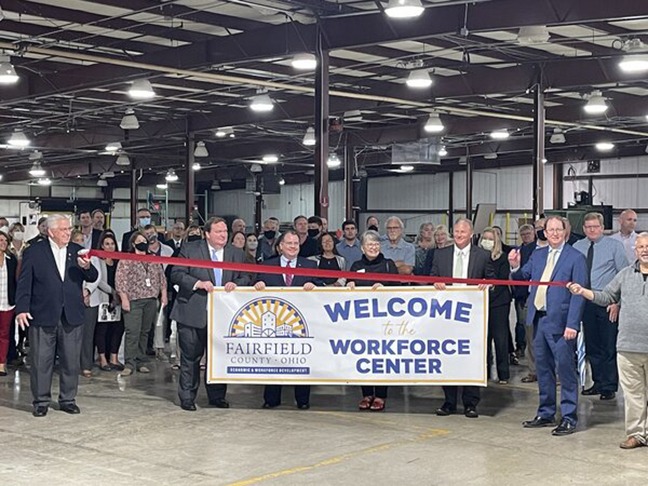
State and local leaders and members of the Ohio University community gather Sept. 22 for a ribbon-cutting ceremony at the Fairfield County Workforce Center. Photo courtesy of the Fairfield County Workforce Center
FORGING NEW PATHWAYS THROUGH TRAINING AND WORKFORCE DEVELOPMENT
In some industries and communities, what’s desperately needed are workers trained in specific skillsets. It’s a reality that has OHIO broadening access to its curriculum and forging new pathways to career success—with or without a degree.
In 2019, the state of Ohio allocated $1.25 million for the Fairfield County Workforce Center (FCWC), investing in a partnership between the Fairfield County Commissioners, Ohio University Lancaster, OHIO’s Russ College of Engineering and Technology, and Hocking College.
The immediate goals of the center? Fill a labor shortage in skilled trades, through programming offered by Hocking College, and meet the employment needs of the community’s growing manufacturing industry, leveraging OHIO’s curriculum.
“Ten percent of our jobs in Fairfield County are in manufacturing,” explains Rick Szabrak, the county’s director of economic and workforce development. “But manufacturing is a lot different today. It’s more high-tech and a career that needs ongoing training and education.”
Last spring, OHIO taught its first class at the FCWC—a machine repair course embedded in the Lancaster Campus’ Engineering Technology program. That course, along with others, will continue to be offered at the workforce center, where college students will learn alongside area residents pursuing independent study or sent by their employers to acquire new skills.
According to Szabrak, that first machine repair class benefitted a local business that enrolled six of its workers. Another business has approached the center about building its employees’ robotics and automation skillset.
This fall, OHIO extended its FCWC courses to include basic electronics, basic hydraulics and pneumatics, automation, robotics, and safety management. It has also registered those courses with the state’s TechCred program, which offers reimbursement to employers whose workers complete credentialed coursework.
“Our hope is that our residents see the center as a place to get the skills to equip themselves for successful careers locally and where they can ultimately get a college degree if they so choose,” says Szabrak. “Think of it as an education highway. You get on that highway and learn a little bit. You exit into a career. You get back on as needed, and you keep going until you reach your destination.”
The FCWC is just one way OHIO is reimagining the way it educates and partnering with community and industry, explains Dr. Todd Myers, BSIT ’88, MBA ’01, PHD ’07, professor and chair of OHIO’s Engineering Technology and Management department and director of workforce and professional development for the Russ College.
“We have opportunities to take a curriculum and break it out into modules, so we’re offering both standalone training and creating stackable certificates that offer multiple pathways to a degree,” he says.
Myers notes plans to create standalone certificates in advanced manufacturing and the possibility of developing industrial credentialing programs, training faculty to be certified on specific brands of equipment and then registering OHIO and the FCWC as providers of that training.
Earlier this year, Russ College faculty underwent training to be able to offer training in 3D printing, robotics and welding at the Russ Research Center in Beavercreek. And the college is working to bring National Institute for Metalworking Skills credentialing into its coursework in response to a need in Southern Ohio identified by the Appalachian Ohio Manufacturers’ Coalition.
“All of this is part of Ohio University’s push to engage industry and grow industry in the state of Ohio,” says Myers. “The Fairfield County Workforce Center is our pilot program in terms of pathways to education and how we’re going to work with industry.”
IN SERVICE TO SOUTHEAST OHIO
OHIO faculty aren’t just educating the professionals of the future. They’re finding ways to serve those already in the field.
A new RHE Workforce Success Initiative is funding six pilot projects developed by regional campus faculty and staff in service to their fields of study and their communities.
This summer, up to 25 regional public safety officials enrolled in the Southern Ohio Public Safety Workforce Development Training, spearheaded by Dr. James McKean, AAS ’80, BCJ ’87, associate professor of law enforcement at Ohio University Chillicothe.
“We want to provide the skills and information, so that law enforcement agencies in our communities can construct actionable work plans and restore trust between police and our communities,” says McKean, pointing to research that finds while 60 percent of the public believes there is a need for systemic police reform, two-thirds of law enforcement officers do not.
The training uses an existing OHIO capstone course, Police Legitimacy and Community Relations, and is taught by McKean and fellow Chillicothe Campus faculty with expertise in psychology and communication.
“In Southern Ohio, many law enforcement agencies lack the resources with which to address contemporary issues,” says McKean. “This initiative provides training to these service region agencies that they probably otherwise wouldn’t get—and at no cost to them.”
The program is continuing through the fall with plans to survey the law enforcement participants and the communities they serve next spring to determine the training’s impact and, hopefully, garner future support for such programming.
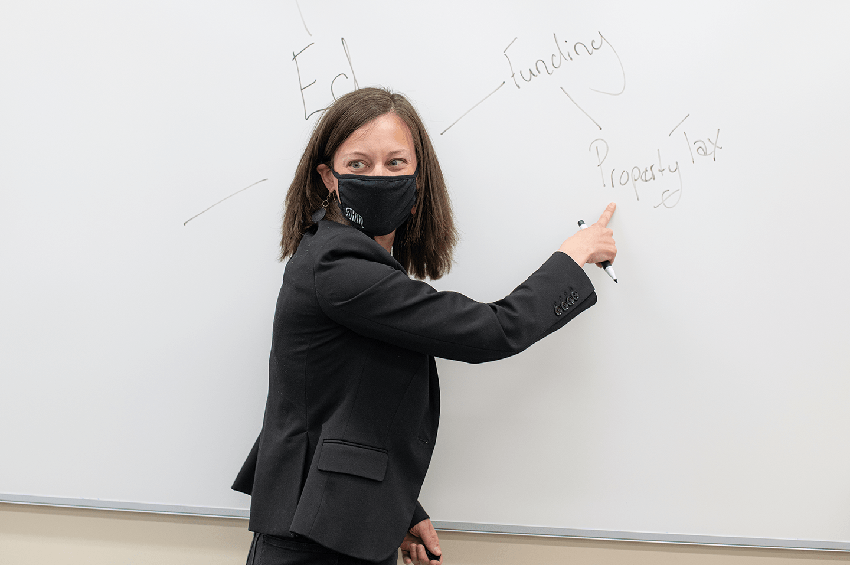
Dr. Jacqueline Yahn, EED ’17, is spearheading a new Rural Teacher Fellowship—one of six pilot projects for the RHE Workforce Success Initiative—this semester. Photo by Rich-Joseph Facun, BSVC '01
Dr. Jacqueline Yahn, EED ’17, assistant professor and program coordinator of Middle Childhood Education at the Eastern Campus, is piloting a Rural Teacher Fellowship.
This academic year, the fellowship is pairing two Eastern Campus-area early-career teachers who are interested in implementing community- and career-oriented learning in their classrooms and districts with two veteran teachers who have extensive experience in this form of teaching and learning.
For the fellows, it provides personalized professional development often lacking at that stage in their careers. For the mentors, it’s a way to share their work and experience and form a relationship with an educator following in their footsteps.
The program is partnering with Building Bridges to Careers, a nonprofit dedicated to fostering student, business and civic relationships to inspire career choice through experience, entrepreneurship and education. It will also include OHIO’s Patton College of Education, with plans for the fellows to work with students and for faculty to lend their expertise to the fellows.
The long-term goal is to expand the number of fellowships, to serve all of OHIO’s regional campus communities and, over time, to build a Rural Teacher Fellowship network.
“This is a natural fit for One OHIO,” says Yahn. “To help our students and the region we serve thrive, we need to continuously ask, what can we do for the community that’s meaningful to them. In Southeast Ohio, we’re geographically isolated in a lot of ways, but there are so many ways to make sure we’re not isolated intellectually or in terms of social capital.”



